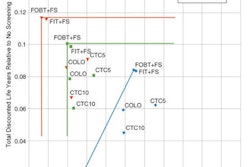
A new analytic model has found that virtual colonoscopy (also known as CT colonography, or CTC) is a highly cost-effective colon cancer screening method for older adults in the Medicare population, especially when combined with screening for abdominal aortic aneurysm (AAA), a test performed using the same CT dataset at little additional cost.
Virtual colonoscopy proponents are hoping that the research will help overcome skepticism from the U.S. Centers for Medicare and Medicaid Services (CMS) regarding reimbursement for VC screening. CMS in February signaled that it did not believe that VC was ready for reimbursement for colon screening studies.
The new study, which appeared online Wednesday before its May publication in the American Journal of Roentgenology, gave VC with AAA a slight edge over optical colonoscopy in terms of life-years gained by screening. VC's additional life-years were largely attributable to the added value of AAA screening in patients 65 years and older, who are at heightened risk of ruptured abdominal aneurysm.
The AJR study underscores the benefits of screening an older U.S. population, a fact that has been under-represented in previous VC screening studies that were aimed at asymptomatic adults 50 years and older. The focus on younger populations, while medically appropriate and in line with guidelines issued by the American Cancer Society (ACS) and other organizations, has led to a dearth of data regarding screening's effectiveness in the Medicare population, comprised of adults 65 years and older. This population is even more severely underscreened than adults 50 and older.
The study specifically addresses CMS' concerns regarding the need for more data on the cost-effectiveness of VC screening in the Medicare population, according to lead investigator Dr. Perry Pickhardt and colleagues from the University of Wisconsin School of Medicine in Madison and the University of Rome "Polo Pontino" in Italy (AJR, May 2009, Vol. 192:10, pp. 1-9).
Aiming to provide screening data for an older population, Pickhardt, Dr. David Kim, and Dr. Andrea Laghi and colleagues from Italy evaluated the clinical efficacy and cost-effectiveness of VC screening in the Medicare population compared to both optical colonoscopy and no screening.
Building a model
The research simulated the development of colorectal cancer (CRC) and AAA in a computerized Markov model in a hypothetical cohort of 100,000 U.S. adults ages 65 to 100 years.
Data on the natural history of colorectal neoplasia were used to produce the age- and sex-specific prevalence at autopsy and screening studies. Surveillance, Epidemiology, and End Results (SEER) data were used to determine the age- and stage-specific incidence of colorectal cancer. Model parameters included polyp transition data, from no polyps to polyps across a range of lesion sizes and disease stages.
AAA data were gleaned from several large studies and U.S. attrition data; AAA prevalence was set at 5.5% for adults age 65 and older and 6.1% for adults age 70 and older. Data on the transition rate from no AAA to AAA were included in the model, and the researchers also accounted for rupture rates and mortality data.
The study compared VC screening at five- and 10-year intervals to primary optical colonoscopy every 10 years and to no screening. At VC, the polyp threshold size for polypectomy was 6 mm. Per ACS guidelines, screening continued until age 80.
Based on screening interval limits recommended by the Working Group on Virtual Colonoscopy, the two separate VC strategies modeled exams every five and 10 years, corresponding to two and four screening exams, respectively, between ages 65 and 80. Colonoscopy, repeated every 10 years if negative, resulted in just two exams during this period.
The model based its costs on Medicare reimbursement for screening and surveillance procedures, converted to 2008 U.S. dollars. Costs of following up extracolonic findings based on the authors' clinical experience were set at $31.
The study evaluated the effectiveness of screening in terms of life-years gained through prevention or downstaging of disease. The group used a base cost per exam of $674 for VC and $795 for optical colonoscopy; the VC cost included the cost of following up extracolonic findings.
Life-year gains cost-effective with all screening strategies
The VC strategies yielded 7,786 and 7,027 life-years gained at five- and 10-year intervals, respectively, compared with 6,032 life-years gained with optical colonoscopy.
The results also showed that performing CTC plus AAA screening every five years resulted in a 29% gain in overall number of life-years compared to optical colonoscopy, while CTC plus AAA screening every 10 years resulted in a 16.5% gain in life-years relative to the optical technique. The gains from CTC were primarily related to the prevention of AAA rupture.
The group found an incremental cost-effectiveness ratio (ICER) of $6,088 per life-year gained for five-year CTC screening, $1,251 for 10-year CTC, and $1,104 for 10-year optical colonoscopy. An ICER of $50,000 per life-year gained is considered the threshold for a cost-effective screening test.
"The ICER between 10-year CTC and optical colonoscopy is essentially negligible," Pickhardt and colleagues noted. "On the other hand, the substantially higher cost of five-year CTC relative to 10-year CTC was not adequately offset by its higher clinical efficacy in this model, such that the ICER [for five-year CTC] was $50,875 -- slightly higher than the adopted threshold for an efficient test."
Compared to no screening, all three screening strategies produced substantial reductions in CRC-related costs that ranged from 52% to 61%, the authors noted. At the same time, costs related to AAA were higher for both CTC screening strategies compared to no screening, and the optical colonoscopy option, which is equivalent to no screening for AAA.
In a Monte Carlo sensitivity analysis, the fifth to 95th percentile intervals of the ICER for five- and 10-year CTC screening approaches compared to optical colonoscopy were $8,383 to $38,118 and $14,568 to $28,319, respectively.
"Therefore, in none of the 10,000 simulations was CTC found not to be a cost-effective alternative compared with optical colonoscopy," they wrote. "Furthermore, the 10-year CTC approach was a cost-saving strategy relative to optical colonoscopy in 30% of the simulations, allowing it to dominate."
Although slightly fewer cancers were prevented using five-year CTC compared to 10-year optical colonoscopy (3,439 versus 3,523), the five-year CTC approach gained more life-years related to CTC than optical colonoscopy (6,250 versus 6,032 life-years). In addition, the 10-year CTC strategy produced a 73% reduction in the number of optical colonoscopy procedures and a 70% reduction in polypectomy cases compared with primary screening with optical colonoscopy.
All three screening approaches were highly cost-effective. As for the important issue of polyp detection sensitivity at VC, reduction in sensitivity for lesions 10 mm and larger from 90% to 64% for 10-year VC and 54% for five-year VC intervals would have been necessary for the ICER relative to optical colonoscopy to exceed $50,000.
The case for VC
Despite its being a largely preventable disease through routine screening, colorectal cancer remains the second leading cause of cancer deaths in the U.S.
"Although Medicare covers certain tests for routine CRC screening -- namely, optical colonoscopy, flexible sigmoidoscopy, barium enema, and annual fecal occult blood testing -- its beneficiaries are grossly underscreened," the group wrote.
A recent study by Cooper at al in a large cohort found that fewer than 25% of average-risk Medicare beneficiaries were screened for colorectal cancer, they noted, adding that VC provides sensitivity for polyp detection comparable to that of optical colonoscopy.
"CTC is also less invasive than optical colonoscopy and does not require sedation, pain control, or recovery time, which are all desirable traits for a CRC screening test, particularly for older adults," they wrote. "Thus, CTC has the potential to greatly improve adherence rates for CRC screening in the Medicare population but is currently not a covered benefit."
The model analysis shows that even without the benefit of AAA screening, CTC is clearly a cost-effective option to address the needs of the underscreened Medicare population, they wrote.
Previous cost-effectiveness studies have focused on the population of individuals 50 years and older and have often lacked polyp-size thresholds for referral to CTC, they noted.
In clinical experience, VC tends to draw in eligible individuals who are currently unscreened, or those who may have barriers to optical colonoscopy screening, including patients on anticoagulation medication or with sedation risks, prior incomplete colonoscopy, fear, or scheduling difficulties. "CTC is an alternative screening strategy [to optical colonoscopy] that results in a similar number of life-years gained," the researchers noted.
Even using conservative data input assumptions, the study clearly shows that CTC is a cost-effective strategy that provides a positive benefit similar to optical colonoscopy yet less invasively, and the modality is intended to work in tandem with optical colonoscopy rather than replace it, reserving the invasive exam for those who need it.
"Given the dire need for increased CRC screening among Medicare beneficiaries, we believe that CTC should be implemented as soon as possible because it has met or has exceeded the key benchmarks achieved by optical colonoscopy and the other currently approved screening options," they concluded.
Whether the new study will affect CMS' decision on virtual colonoscopy reimbursement remains to be seen. The 30-day comment period on the agency's proposal to reject VC screening ended March 12, and a final decision is expected in the coming weeks.
By Eric Barnes
AuntMinnie.com staff writer
March 26, 2009
Related Reading
Colonoscopy seen as reducing CRC mortality in Germany, March 23, 2009
ACR urges Congressional support for CT colonography, March 16, 2009
Reminders may increase colon cancer screening rates, February 26, 2009
CMS rejects case for virtual colonoscopy reimbursement, February 12, 2009
Adverse events weigh on colonoscopy mortality equation, February 6, 2006
Copyright © 2009 AuntMinnie.com



















